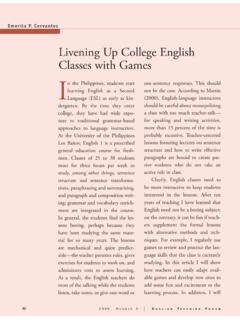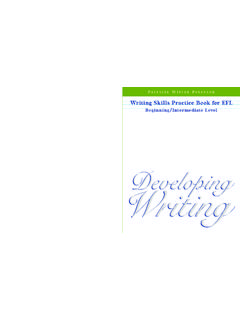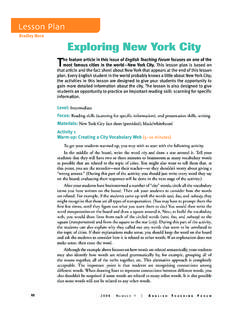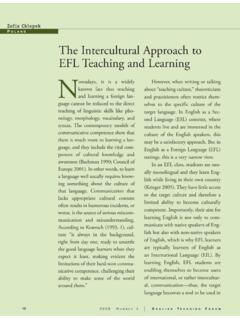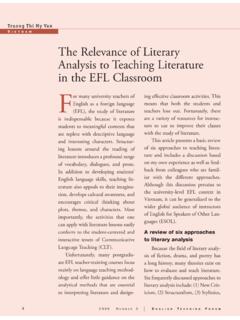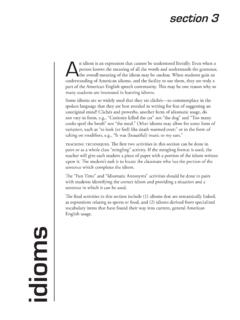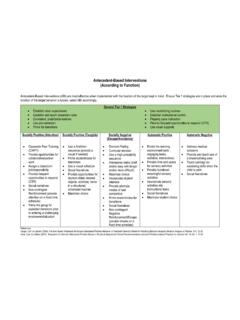Transcription of Giving and Responding to Compliments - American English
1 Giving and Responding to Compliments Noriko Ishihara University of Minnesota, United States Level: High intermediate level, adult ESL students Time: Four lessons, 40-50 minutes per lesson Resources: Handouts adapted from Manes & Wolfson (1981), Billmyer (1990), Dunham (1992). Goals: To raise learners' awareness of pragmatic rules; to increase input to learners and opportunities to observe native English speakers' pragmatic behavior Description of the Activity This unit begins by having learners individually complete a pragmatics inventory. Using their responses to the inventory, learners share their perspectives about complimenting behavior in English and their native countries in a class discussion, which gives them the opportunity to voice their varying expectations and cultural differences. In my classes, for example, Asian learners were shocked by the frequency and explicitness with which Spanish speakers give Compliments in their cultures; other learners were fascinated by the way Arabic speakers respond to Compliments in their language.
2 Some learners guessed that people of higher status were more likely to receive Compliments . Since this did not correspond to findings in the class readings, learners were motivated to conduct their own survey on complimenting behavior. In the next stage of the unit, learners collect samples of native speakers'. Compliments and responses and study them to see whether their own findings conform to those reported for American Compliments . Each learner collects at least three Compliments and responses by listening to native English speakers or by sincerely complimenting them. The learners then jot down the interactions immediately following each conversation. This combination of data collection and production encourages learners to observe and analyze native speakers'. Compliments and to use Compliments in their own conversations. I have found that some learners continue the use of Compliments beyond the classroom instruction.
3 Although a few learners have reported awkwardness in conducting the survey, they generally enjoy experimenting, and they learn the importance of being sincere in Giving Compliments . This initial learner involvement is intended to raise learners' pragmatic awareness and provide authentic linguistic input. After Compliments themselves are investigated, learners complete an optional worksheet on cultural values as reflected in Compliments (see Teacher Resources). To attain the second objective, increasing learners' input, findings from learner-collected data and good transcripts are shared in class, and speaking exercises are conducted at several points. In the speaking exercise (a "mingling" activity), learners practice Giving and receiving Compliments . They form two concentric circles, facing a partner. The students in the outside circle look at their partner, find some nice quality on which to compliment them, then give a compliment.
4 The students in the inside circle respond to the compliment. The circles then move over by one person (the students change partners), and they repeat the exercise. When they have completed the circle, they switch roles and go around again. Advise your students that they do not always have to accept Compliments ; they can express themselves in the way most comfortable to them, including, perhaps, using a deflection strategy such as downgrading, questioning, or shifting credit. This activity functions as a good springboard for even more learner-initiated practice since learners generally start complimenting each other for pleasure before and after class. After studying the function of complimenting as a conversation opener, learners also practice initiating a conversation with Compliments , extending the topic, and sustaining the conversation. Procedure 1. Introduction: Day 1.
5 A. General warm-up and introduction to pragmatics b. Introduce the concepts of Compliments and flattery. Teach related vocabulary ( , compliment/butter up/apple polish). c. Present a sample dialogue of complimenting between instructors. d. Initial inventory. Have students individually complete the following pre- instruction inventory 1) How often do you hear people complimenting each other in English ? 2) What do people say and how do they respond to Compliments in English ? 3) Do you give and/or receive Compliments in English ? Are you always comfortable with the way you exchange Compliments in English ? If no, when do you feel uncomfortable and why? 4) What do people say when they give and receive Compliments in your country? Provide a literal translation of some examples. 5) What do people compliment others on? 6) Who is more likely to exchange Compliments ? 2. Student research a.
6 Introduce the findings of Manes and Wolfson's research (1981): 85 percent of 1200 Compliments consists of the first three sentential patterns, 97 percent consists of nine patterns. (See Teacher Resource). b. Students collect Compliments and compare them with patterns reported in earlier research. Students should collect three to five Compliments each. If students collect Compliments by means of a tape recorder rather than note taking, they may need permission from the speakers. They may also need help transcribing their data. Teachers will probably want to look over the transcriptions before they are distributed to the class. The use of an observation worksheet can help learners (see Teacher Resource). Allow enough time for learners to receive or overhear naturally occurring Compliments . 3. Awareness of Contextual Variables and Practice: Day 2. a. Review the most common nine sentential patterns discussed in step 2.
7 Student Research and have learners identify some of the patterns in their own data. b. Discuss contextual variables (gender, role, age, and relative status), and have learners analyze their own transcribed data with regard to such variables. Students may refer to their observation worksheets. c. Discuss sincerity in Giving Compliments and have learners evaluate the appropriateness of their transcribed interactions. d. Have students role play good examples with each other and practice complimenting in pairs. e. To prepare for the teaching of compliment responses, have learners sincerely compliment three native English speakers then jot down their responses immediately after each conversation. 4. Responses to Compliments : Day 3. a. Model short exchanges between instructors using "responses to Compliments ". in Teacher Resource. Elicit learners' observations of each interaction, and teach four self-praise avoidance strategies (downgrading the compliment, questioning the compliment, shifting the credit away from themselves, and returning a compliment) as types of responses that deflect Compliments .
8 B. Share some good transcriptions by the learners (see homework assignment in 4b above) and have the whole class identify the Responding patterns. c. Practice Giving and Responding to Compliments in a mingling activity. Students form two concentric circles, each facing a partner. One Compliments the other, who responds. The outer circle rotates and each student finds a new partner and repeats the process; the circles switch roles after practicing sufficiently. 5. Compliments as a Conversation Opener: Day 4. a. Model the conversation with Compliments as openers (see Teacher Resource). Have learners highlight topics, point out the rapidly shifting topics, and identify the conversation-opener function of complimenting. b. Have learners in pairs practice opening a conversation with a compliment and develop it. 6. Conclusion a. Final inventory. Have students complete the post-instruction inventory individually.
9 1) Write down an imaginary compliment interaction as you would say it. 2) After studying Compliments , how do you feel about Giving and receiving Compliments in English ? 3) Did the classroom information help you feel more comfortable about Giving and receiving Compliments ? b. Show a list of other functions of language and have students indicate their interests in such acts. (This can be done as the final question of the inventory: 4). Are you interested in learning about other functions of English ? Check the ones you are interested in: greeting, thanking, inviting, refusing invitations, requests, apologies, congratulating, offering condolences, addressing people.). Rationale Complimenting is a tool for establishing friendship that creates ties of solidarity. It also is an important social strategy in that it functions as an opener for a conversation and allows meaningful social interaction to follow.
10 Neglecting to give Compliments may even be understood as a sign of disapproval, and the inappropriate use of Compliments may cause embarrassment and even offense. The speech act set of Compliments has highly structured formulas with rather simple linguistic structures. According to Manes and Wolfson (1981), 85 percent of American Compliments contained one of three simple sentential patterns. The great majority of Compliments included the most common five adjectives (nice, good, beautiful, pretty, and great) and two verbs (like and love) ( ). Despite the relative linguistic simplicity of compliment form, the act of complimenting is not simple. Prior to the instruction, I consulted eight ESL textbooks to investigate how they teach pragmatic behavior. Although innovative ideas can be found, especially in recent textbooks, it is hard to find an approach that highlights the cultural nature of complimenting, that requires learners' initiative in observing the linguistic and pragmatic rules, and that exposes learners to the motivating influence of authentic input.

